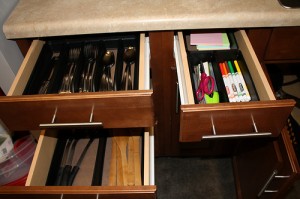When I decided to organize my junk drawer two weeks ago, I did what most folks do — I purchased a drawer divider set with a variety of different sizes. The idea is to group like things together. The pencils go in one section, pens in another. Littler compartments hold paper clips and Box Tops. And the biggest container is for my precious scissors, which seem to go missing at least once every other day.
In fact, this is the No. 1 tennet of organization: A place for everything and everything in its place. If I have a designated spot for my daughter’s erasers, they won’t be strewn around my kitchen counters or tossed into the silverware drawer. (And she won’t be screaming in a fit of last-minute homework, “I can’t find an eraser!)
At least that’s the idea.
And that idea is as old as dirt. In fact, it has its roots in mathematics, specifically set theory, which wasn’t formalized until Georg Cantor, a German mathematician, published an article on the subject in 1874. This blew the socks off of the mathematics community — mainly because he proposed that there are two kinds of infinities.
But I digress.
Kindergarteners learn about set theory, when they circle like things on a worksheet. And many parents probably wonder why this is such a big deal.
In short, set theory is the basis of our numerical systems — among many other things. Mathematics craves order. Knowing why things are alike or different can help us solve problems quickly and effortlessly. Just like knowing where my scissors go (and putting them there) makes it easier for me to find them later on.
As an example, let’s look at the set of whole numbers.
{0, 1, 2, 3, 4, 5, 6, 7, … }
(Okay, just so no fancy-schmancy mathematician jumps down my throat, I have to note here that there is some disagreement about whether 0 belongs in this set. But for most of the rest of the world, that’s a point not worth arguing about.)
When you know the set of whole numbers, you can determine whether or not a number is in that set. For example:
0.25 is not a whole number
60% is not a whole number
π is not a whole number
-17 is not a whole number
But: 6,792,937 is a whole number
But why do you care? Honestly, I think the biggest reason is so that you can talk about math. In this case, set theory tells us the difference between whole numbers, integers, decimals, rational numbers, etc. — even if you don’t remember what all of these are.
(And those of us who know a little bit about math also know that whole numbers are in the set of integers, which are in the set of rational numbers, which are in the set of decimals.)
So this is how math is like organizing. Both depend on set theory.
I’m not saying that you have to be organized to do math. Lord knows I’m not. But the underlying organization of math points to big clues about how it’s done. Even more basic sets, like geometric shapes can apply in our everyday lives.
The bottom line is this: If you think you can get your house or office or car organized (and I believe you can!), you can certainly organize all of what you know about math and put it to good use. That way, you’ll always know where your area of a triangle is.
How do you think about the structure of numbers or shapes or arithmetic operations? This points to your intuitive understanding of set theory. Share your thoughts in the comments section!
